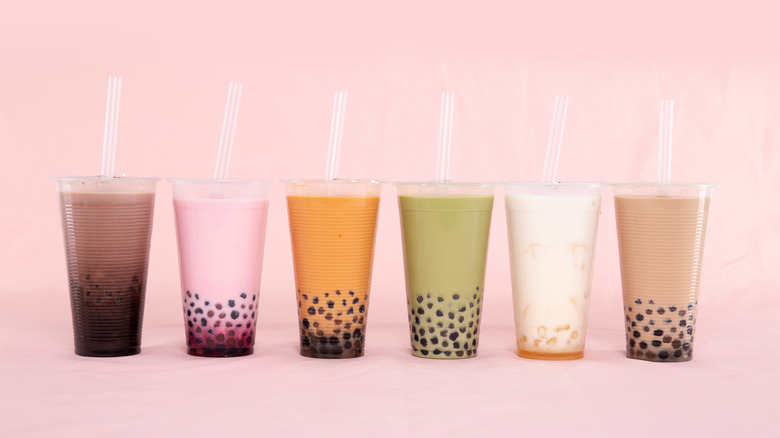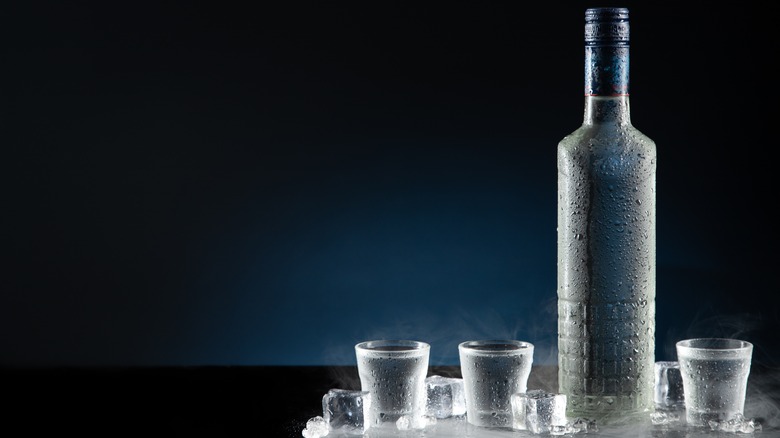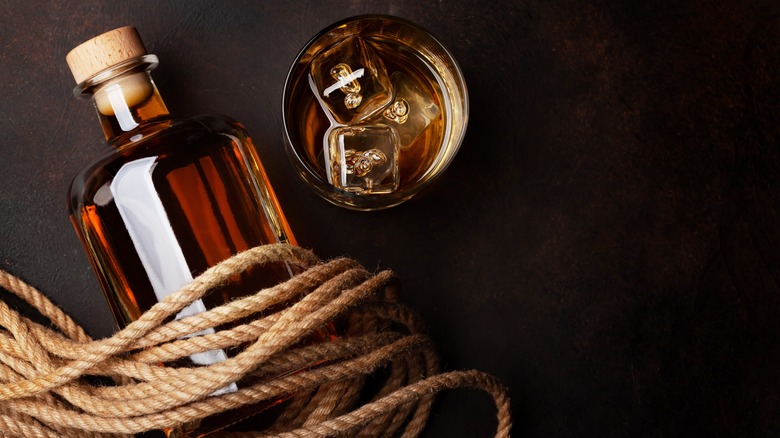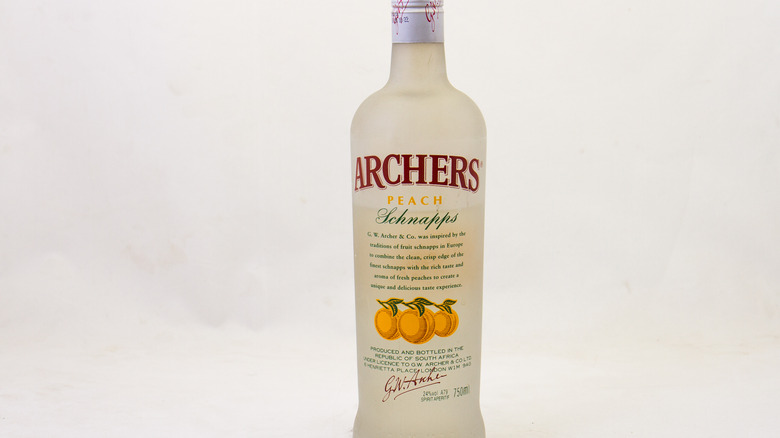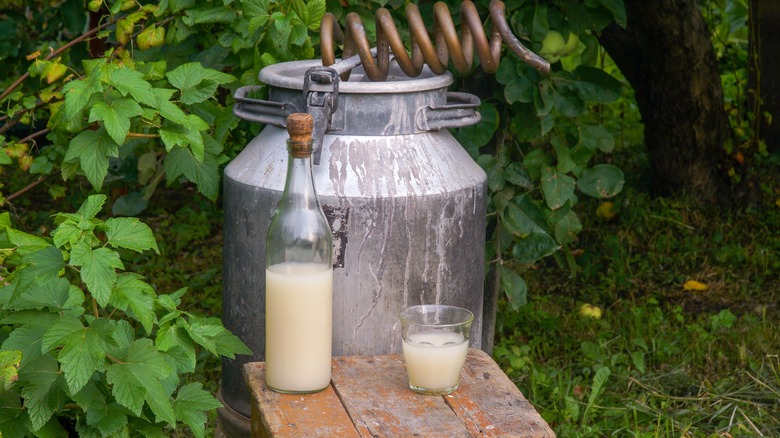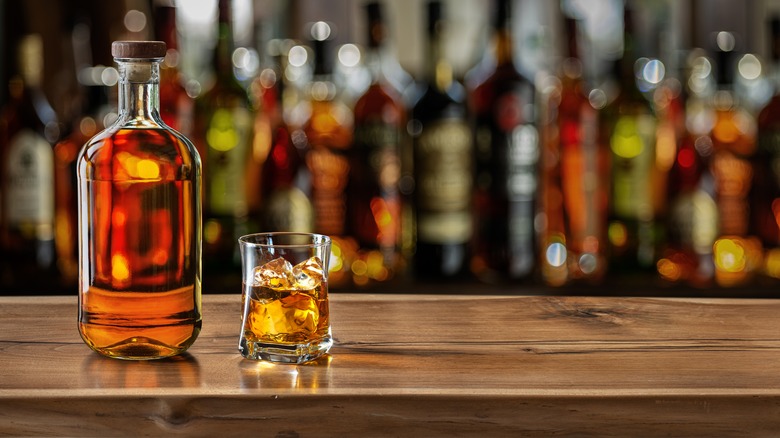The 12 Absolute Best Spirits To Spike Your Boba Tea
The origins of boba tea (also known as bubble tea) are as murky as the Instagrammable drinks themselves, but the popularity of these colorful sippers is hardly mysterious. When flavorful tea, creamy milk, sugar or flavored syrup, and gummy tapioca pearls are combined into a single beverage, something magical occurs. Boba tea emerged somewhere in Taiwan in the 1980s, and by the early years of the 21st century, the dessert-like drink had begun to gain traction in the United States. Fast forward to today, and we're looking at an impressive empire. According to GlobeNewswire, the global market size for bubble tea was valued at roughly $2.1 billion USD in 2020 and is expected to grow by a whopping $4.5 billion USD as early as the year 2026.
Part of these beverages' raging popularity is the number of flavor combinations available for bubble tea. Bases can range from herbal teas to fruit juices, milk can be any kind available, flavoring could be anything from simple syrup to sugar or stevia, and toppings are whatever floats your boat (or rather, whatever floats or sinks in your drink). Although bubble teas are traditionally non-alcoholic, you'll find spiked boba drinks at many bars and restaurants these days; and with so many options to play with, mixologists have come up with some wild combinations. If you want your boba with a boozy punch, here are some ways to get started.
Vodka
When it comes to spiking drinks, vodka is a pretty solid bet. Non-flavored vodka has an astringent taste, but when added to cocktails and mixed drinks, it doesn't affect the flavor of the beverage as much as some other liquors. That's not to say that all vodka tastes the same — that the spirit is without its own distinct properties is a myth about vodka that avid drinkers of the liquor will jump at the chance to argue against. Still, given its neutral scent, taste, and clear color, adding vodka to boba is a great way to dip your toes in the water if you're looking for an introduction to tea cocktails.
You'll find boba spiked with vodka on the menu at lots of bars, restaurants, and boba shops that sell boozy bubble teas. At PABU, a San Francisco restaurant, the head bartender dreamed up a whole line of "Spirited Away"-themed cocktails, one of which featured vodka, manzanilla, plum, citrus, egg white, and boba that was dubbed Haku's Lair. Don't worry — your spiked bubble tea doesn't need to be nearly as extravagant. Try adding vodka to a creamy orange boba to mimic a screwdriver cocktail, or add a splash to a bubble tea with cranberry for a take on a vodka cran. Looking for something a little more out there? There are hundreds, if not thousands, of flavored vodkas available for maximum sensory impact.
Creme de cacao
Some folks prefer their boba to taste like actual tea. Others make a beeline for juicy, fruit-forward flavors at their favorite bubble tea shop, and still, others seek dessert in a cup. If you fall into that last category, spiking your boba with creme de cacao could be the move for you. There are two different methods for producing creme de cacao, and each results in a different flavor. Percolating (a method similar to brewing coffee) yields a darker liquid with a rich chocolate flavor, while distilling brings out a clear color with a lighter chocolate taste.
Though there are different types of creme de cacao with distinct tastes, most people still consider it to be a dessert drink, and there's nothing wrong with that! Who doesn't love a decadent chocolate martini or a creamy and refreshing grasshopper cocktail? Creme de cacao does not typically have a pungent alcoholic taste when added to cocktails and makes a wonderful addition to boba. Indulge your sweet tooth by adding creme de cacao to bubble teas with coffee, mocha, or even chai flavors — the rich, chocolatey taste of the liqueur is sure to scratch the itch when you're craving a sweet treat with a little extra kick.
Gin
Ah, gin. According to World Gin Club, the liquor has been around since Dutch doctor Franciscus de la Boe, capitalizing on the known medicinal benefits of juniper berries, developed it in the 16th century. Today, various types of gin can be found all around the globe, and its distinctive piney taste and aroma have amassed a loyal fan club of G&T-sipping devotees. Bartenders love dreaming up gin-infused concoctions with flavors like lemon, lavender, and cucumber; but the liquor can be quite versatile if you're willing to use your imagination.
When it comes to adding gin to bubble tea, there's a plethora of fascinating avenues to consider. If you're a classic gin and tonic fan, you might enjoy a lime-forward boba with a shot of gin to mimic the lime-and-pine combination in the well-loved cocktail — you could even add a splash of tonic for extra bubbles. High-end cocktail connoisseurs may appreciate the effect gin can have on more fruity and floral bubble teas like pineapple, raspberry, or hibiscus. Those drawn to the grassy, earthy taste of matcha may be pleasantly surprised by a matcha gin cocktail (just add the tapioca pearls for a chewy pop of texture). Bear in mind that in most cases, gin is best served in boba teas with a tea or fruit juice base versus something creamy — gin and milk sound like a tummy ache waiting to happen.
Soju
If you live in the United States, you may not have heard of soju before, but this liquor — which is similar to vodka, but sweeter and with a much lower alcohol content — is actually one of the best-selling spirits in the world, (per The Spirits Business). Distilled from rice, water, and a wild fermentation starter called nuruk, soju can be consumed straight, as a shot, combined with a beer in a soju bomb, or added to mixed drinks and cocktails. Like vodka, plain (non-flavored) soju typically does not have a particularly pungent alcoholic taste — it's a versatile spirit that will effortlessly blend with all kinds of boba.
There are, however, plenty of flavored sojus around, so if you really want to take your bubble tea to the next level, look into these. Max out a piña colada-inspired boba by adding pineapple soju to a pineapple and coconut milk bubble tea, or try mixing peach soju with a strawberry milk tea for an explosion of fruity explosion. Some soju brands make some wild flavors — Chateul Soorok, for example, has an Americano flavor that would be delightful in a coffee-based drink, while Bohai Soju's honey soju could serve as a great sweetener for an earl grey bubble tea.
Rum
Rum tends to get a bad rap if you ask people who spent their college years drinking flavored Bacardi and Coke. There's absolutely nothing wrong with that classic combo, but there's a huge slice of the population that remains completely ignorant about the wide variety of rums available to us today. Though almost all rum is distilled from sugarcane, seasoned rum drinkers will tell you that different types of rum – depending on their age, the method of distillation used, and other factors — can range in flavor from smoky to sugary sweet to something almost resembling whiskey. There's a rum out there for pretty much everybody, and experimenting with rums of various origins, ages, and distillation methods is a blast ... after all, who doesn't like to indulge their inner Jack Sparrow once in a while?
When it comes to spiking bubble tea with rum, the plethora of rum options allows for a huge array of combinations that will have you in a beachy state of mind within a few sips. If you're a fan of the vacay-favorite mai tai cocktail, an orange and pineapple bubble tea with coconut milk and shots of dark and Malibu rum is sure to float your boat (don't forget the maraschino cherry). Dark rum drinkers may appreciate a boba-fied take on a dark 'n stormy – experiment with mixing lime-flavored bubble tea with ginger beer and pouring in an ounce or so of dark rum.
Peach schnapps
Schnapps originated in Germany in the 1800s, and, according to BlackTailNYC, the clear, sweet liquor became popular in the United States in the mid-20th century. Today, consumers can find a wide variety of flavors for the 30 to 50-proof spirit, and certain flavors (cinnamon, apple, peppermint, and peach, as reported by the Virginia Alcoholic Beverage Control Authority), emerging as clear favorites. While cinnamon and apple schnapps make warming additions to fall cocktails, and nothing screams "Christmas" like a shot of peppermint schnapps in hot cocoa, peach is the perfect schnapps flavor to seek out when late summer arrives.
Schnapps is made by distilling real fruit, herbs, or spices, so most schnapps varieties have a true fruit taste when compared with some other flavored liquors that call on artificial ingredients for their taste. This rings true for the tender, delicate flavor of peach schnapps — the spirit has an authentic, fruity peach punch that will easily brighten up bubble teas with herbal tea bases (think peach green tea) or fruit-forward boba like grapefruit, strawberry, or kiwi. Whatever you choose, the inclusion of glutinous boba pearls in a bubble tea and peach schnapps cocktail is sure to lead to a texturally-pleasing delight.
Bourbon
Unlike other types of whiskey, bourbon is a uniquely American invention and differentiates itself from the rest of the whiskey crowd in that the primary ingredient in all bourbon (making up at least 51% of the grain mix) is corn. It's corn that gives this spirit its characteristic sweet, smoother-than-whiskey taste, which usually features notes such as vanilla, honey, and caramelized sugars. Bourbon is a popular choice when it comes to spiking drinks. Bourbon's dessert-like flavors make a warming and welcome addition to cocktails like Moscow mules and bourbon smashes, and pouring a shot of bourbon directly into a toasty mug of holiday coffee or cocoa is certainly not unheard of.
When it comes to spiking bubble tea with bourbon, the sky's the limit. Bourbon is one of those rare spirits that pairs easily with a huge variety of flavors; giving an unexpected kick to fruity drinks like lemonade and adding a rich sweetness to traditional sweet-course beverages like coffee and strong tea. The menu at one New York City boba tea shop (Tea and Milk) highlights a masala chai bubble tea, and we're willing to bet that the spicy taste of masala chai coupled with a shot of bourbon would be a winning combo.
Baileys
Dessert drink aficionados often have a love for Baileys Irish Cream, the Irish whiskey, cream, and cacao-based liqueur that's taken the world by storm since the mid-1970s. Baileys manages to strike an impressive balance between its three primary ingredients, none of them overpowering the next. The spirit is popular in both desserts (like boozy, Baileys-filled donuts and Irish cream chocolate fondue) and cocktails.
Baileys' sweet taste makes it a prime choice when it comes to dessert-like beverages. If you want a safe bet to begin your boba-spiking journey, Baileys pairs beautifully with coffee or chocolate bubble teas — but there's no need to stop there. Add Baileys to a milky strawberry boba to simulate the chocolate strawberry milkshake of your youth (with the extra-fun bonus of gummy tapioca pearls), or allow the rich taste of Irish cream to play off the aromatic flavors of a black tea-based drink. In fact, the Baileys website actually features its own recipe for a cocktail dubbed the Bailey's Boba Sunrise: an enticing-sounding beverage featuring the liqueur, coconut cream, Thai tea concentrate, turmeric honey syrup, and boba pearls, of course.
Kahlua
Kahlua bears many similarities to Baileys, not least of which is that Kahlua is typically considered a dessert liqueur; however, there are some key differences between Baileys and Kahlua that warrant consideration. Baileys, being cream-based, has a much lighter color and a predominantly creamy texture. Kahlua, on the other hand, is a coffee-based liqueur crafted with rum versus whiskey and features a dark, translucent color. The two spirits are often added back-to-back in cocktails, and, in fact, the menu at KOGI (a Korean-inspired restaurant in Richmond, Virginia) includes a Baileys and Kahlua milk tea cocktail complete with black boba pearls.
Kahlua may seem an obvious choice if you're considering a spirit to spike your coffee, chai, or chocolate-inspired bubble tea, but bear in mind that the coffee liqueur has a much less viscous consistency than its counterpart, so if you're seeking a real coffee-and-cream concoction, you'll want to be sure to add a splash of milk in order to achieve that gorgeous, swirling, cloudy look and taste. The semi-bitter taste of coffee can also be a great way to mellow out the sweetness of fruit and berries, so those who crave a drink that combines the best of both worlds might consider mixing Kahlua with boba that features the tastes of tart cherry or raspberry, citric orange, or even banana (a fairly elusive bubble tea flavor) for a breakfast twist.
Tequila
What comes to mind when you think of tequila? Shots with salt and lime? Salt-rimmed margarita glasses? An elusive bottle of Don Julio 1942? Few liquors compare to tequila when it comes to spirits that scream "let's get this party started!" Tequila, however, has a long, checkered history that can be traced nearly 2,000 years back, (per Drinks Geek), and, of course, a liquor with such a storied evolution has by now expanded into a spirit category with an abundance of forms. Different types of tequila have their own special properties that make them unique, but generally speaking, tequila of all types is noted for its sweet, spicy, and sometimes almost earthy taste.
Because tequila has a strong and distinctive taste with a tendency to shine through regardless of what it's mixed with, combining it with bubble tea is a bit more complex than it is with less flavorful spirits like vodka or non-flavored soju. The bright taste of blanco tequila naturally plays well off of sweet and sour citrus (hence, the usual lime wedge served with your shot), so bubble tea flavors like lime, orange, grapefruit, or lemon are a good place to start experimenting. On the flip side, more bitter citrus fruits like grapefruit make particularly apt pairings for a reposado, añejo, and extra añejo tequilas, considering these aged tequilas' smoky element.
Moonshine
Residents of the U.S. South have been making the high-proof, homemade, whiskey-derived spirit known as moonshine for centuries in Mason jars in their freezers, but this liquor has come a long way since the early days of Scottish and Irish immigrants who migrated to the southern United States. Moonshine is a whole lot more than just a corn-based whiskey drink, and it's making a comeback in the U.S.: Multiple brands, including the renowned Buffalo Trace Distillery, are bottling up and selling their own versions of moonshine.
Moonshine nowadays comes in a lot of different flavors — take this homemade apple pie moonshine recipe, for example — so there's a lot you can do with bubble tea and moonshine combinations. Consider adding a splash of the apple pie moonshine to a caramel milk tea boba, or pouring a shot of peach moonshine into a green tea-based bubble tea. Commercially-made moonshine batches are not exactly akin to the real deal, (per The Whiskey Wash), due to state and federal laws concerning alcohol, but the mass-produced moonshine varieties that distilleries like Buffalo Trace are churning out are (pardon our pun) well worth a shot.
Whiskey
Whiskey may be last on this list, but it's certainly not the least. Merriam-Webster describes whiskey as "a liquor distilled from fermented wort (such as that obtained from rye, corn, or barley mash)," which allows for a wide range when it comes to defining what constitutes whiskey. The world of whiskey encompasses many of the most-beloved brown liquors, including scotch, malt, and the aforementioned bourbon, for starters. In fact, whiskey accounted for four of the top 10 best-selling liquor brands worldwide across all categories in 2021, according to The Spirits Business.
Whiskey is a fairly versatile spirit, and while each drinker has their preferred method for consuming it (neat, on the rocks, with a splash of water, and so on), it's popular to add whiskey to mixed drinks. Different whiskey varieties can vary wildly in taste depending on the region in which they're produced, how long they're aged, and what ingredients are used in the distillation process. But as a whole, most whiskeys have a sweet, smoky, nutty flavor that can nicely complement boba tea. Try adding whiskey to a cherry-flavored boba for a woody flavor (perhaps with a splash of Coca-Cola in addition to boba pearls), or mixing the spirit with a tea-based cocktail with a lemon wedge to mimic a John Daly, the whiskey drinker's take on an Arnold Palmer.
